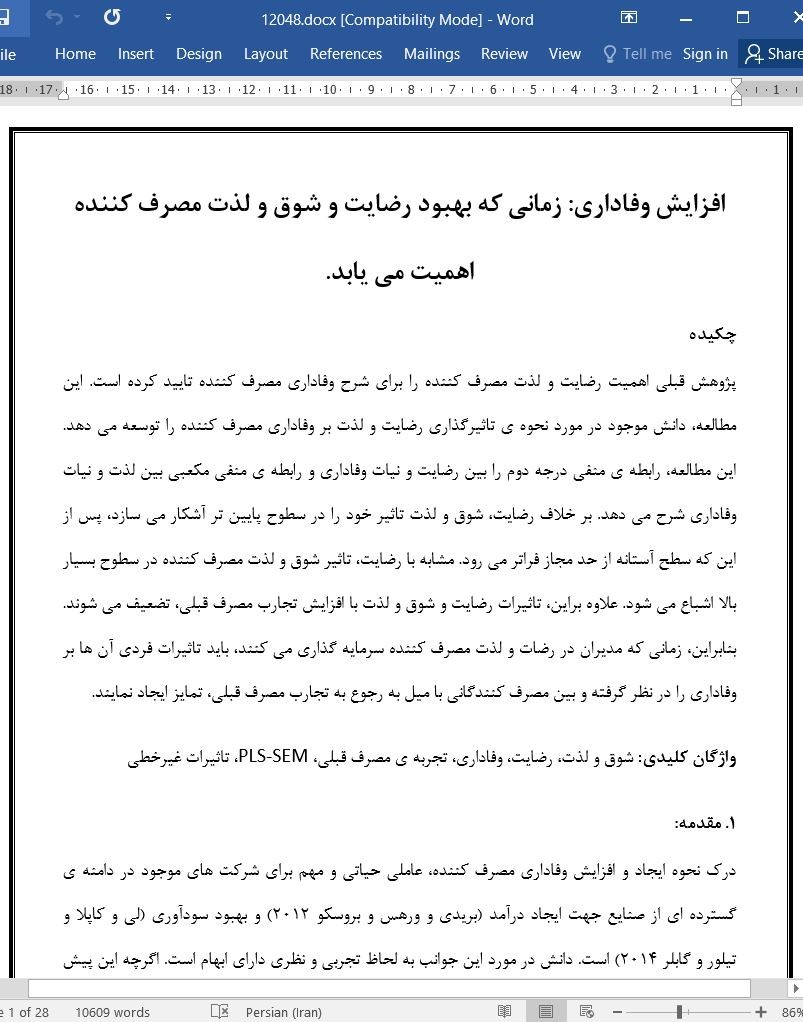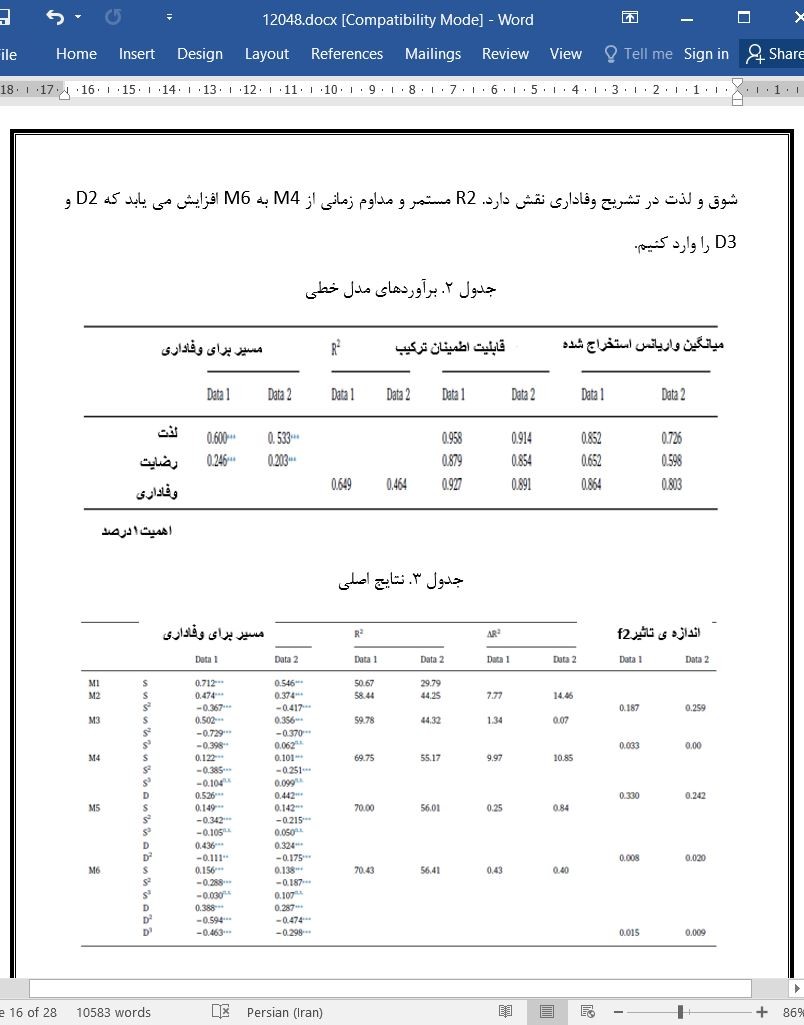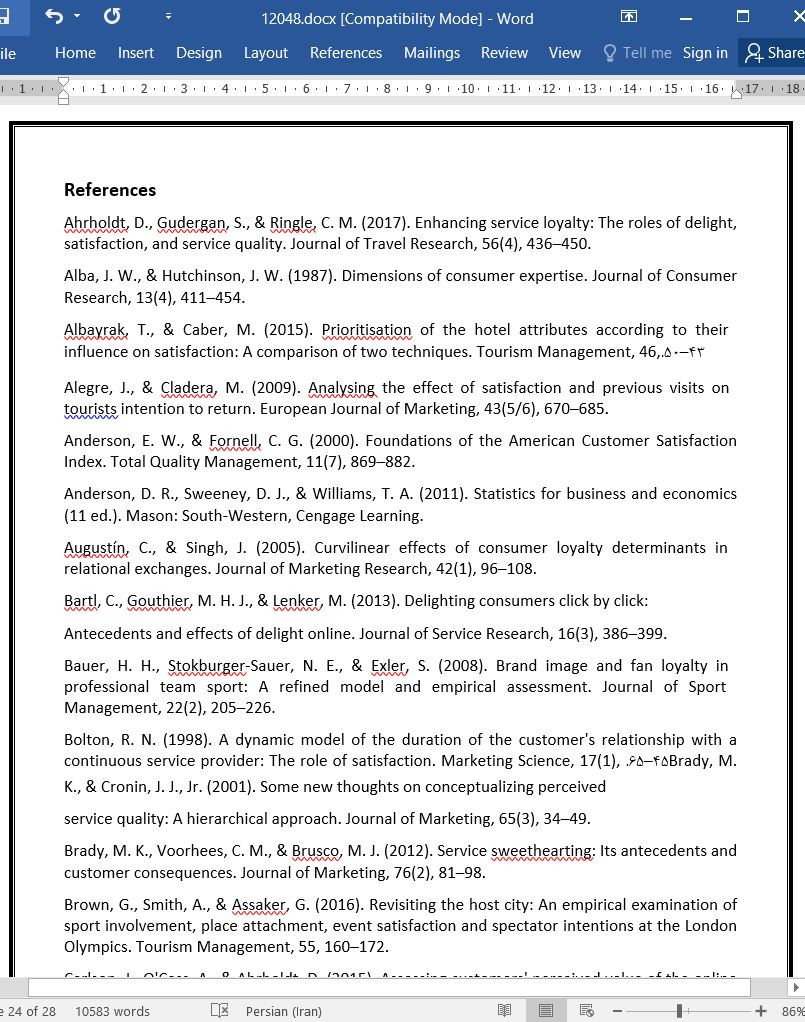
افزایش وفاداری: زمانی که بهبود رضایت و شوق و لذت مصرف کننده اهمیت می یابد.
چکیده
پژوهش قبلی اهمیت رضایت و لذت مصرف کننده را برای شرح وفاداری مصرف کننده تایید کرده است. این مطالعه، دانش موجود در مورد نحوه ی تاثیرگذاری رضایت و لذت بر وفاداری مصرف کننده را توسعه می دهد. این مطالعه، رابطه ی منفی درجه دوم را بین رضایت و نیات وفاداری و رابطه ی منفی مکعبی بین لذت و نیات وفاداری شرح می دهد. بر خلاف رضایت، شوق و لذت تاثیر خود را در سطوح پایین تر آشکار می سازد، پس از این که سطح آستانه از حد مجاز فراتر می رود. مشابه با رضایت، تاثیر شوق و لذت مصرف کننده در سطوح بسیار بالا اشباع می شود. علاوه براین، تاثیرات رضایت و شوق و لذت با افزایش تجارب مصرف قبلی، تضعیف می شوند. بنابراین، زمانی که مدیران در رضات و لذت مصرف کننده سرمایه گذاری می کنند، باید تاثیرات فردی آن ها بر وفاداری را در نظر گرفته و بین مصرف کنندگانی با میل به رجوع به تجارب مصرف قبلی، تمایز ایجاد نمایند.
1. مقدمه
درک نحوه ایجاد و افزایش وفاداری مصرف کننده، عاملی حیاتی و مهم برای شرکت های موجود در دامنه ی گسترده ای از صنایع جهت ایجاد درآمد (بریدی و ورهس و بروسکو 2012) و بهبود سودآوری (لی و کاپلا و تیلور و گابلر 2014) است. دانش در مورد این جوانب به لحاظ تجربی و نظری دارای ابهام است. اگرچه این پیش فرض وجود دارد که تلاش ها برای تقویت رضایت می تواند وفاداری را افزایش دهد (کارلسون، اوکاس 2015، هاکمن و وانگ و دانیل 2006، وو 2016 سو و پارک 2016)، کومار و پوزا و گانش در سال 2013 و کولتمان و شارما در سال 2015 بیان کردند که ارتباط بین رضایت و وفاداری قوی تر از ان چیزی نیست که در نظر گرفته می شود. برای مثال، این رابطه ممکن است غیرخطی باشد (کومار 2013) و شوق و لذت ممکن است بر وفاداری تاثیر گذارد (الیور و روست و وارکی 1997)، این بدین معناست که در نظر گرفتن رضایت به عنوان عاملی مقدم و سابقه ی خطی از وفادار، کافی و کارامد نخواهد بود.
6. نتیجه گیری
کومار در سال 2013 بیان کرد که مدل های پیش بینی کننده ی وفاداری نه تنها باید دربردارنده ی رضایت باشند بلکه به لحاظ نظری باید سوابق و عوامل مکمل، میانجی ها و روابط غیرخطی را اثبات نمایند. الیور در سال 1997 بینشی را در مورد نقش مهم و مکمل لذت به عنوان یک محرک وفاداری ارائه نمود اما اغلب نادیده گرفته شد. لذت، پاسخ احساسی کلیدی به یک تجربه ی مصرف است. با این وجود، پزوهش قبلی در مورد نحوه ی تاثیرگذاری رضایت و لذت بر وفاداری، یافته ها و مفهوم سازی های ناسازگاری را ارائه نمود. پژوهش ما با شناسایی محدودیت های کلیدی موجب پیشرفت درک ما از تاثیرات متناظر رضایت و لذت بر وفاداری می شود. با تمرکز بر وقایع ورزشی به عنوان یک بخش در حال رشد در صنعت خدمات و تضمین اعتبار بیرونی، از مجموعه ای استفاده می کنیم که دارای پاسخ های احساسی مانند لذت است. علاوه براین، با ترسیم دو پایگاه داده و ارائه ی قضاوت هایی از تجارب مصرف واقعی، در می یابیم که نظریه ی چشم انداز برای حوزه ی وفاداری نیز قابل کاربرد است زیرا بیان می کند که قضاوت های وفاداری برای لذت و رضایت، وابسته به مرجع هستند. رابطه ی درجه دوم منفی بین رضایت و وفاداری و رابطه ی مکعبی منفی بین لذت و وفاداری مورد تایید قرار گرفتند. با توسعه ی مفهوم سازی غیرخطی و تکیه بر چارچوب دسترس پذیری-قابلیت تشخیص، به لحاظ نظری نقش مشارکت مصرف کنندع را با استفاده از LPE به عنوان یک میانجی مشخص می کنیم. داده های تجربی ما از تاثیر میانجی و منفی LPE بر بخش های اصلی روابط رضایت-وفاداری و لذت-وفاداری حمایت می کنند.
Abstract
Prior research has validated the importance of consumer delight and satisfaction for explaining consumer loyalty. This study extends our existing knowledge of how delight and satisfaction affect (in a nonlinear way) consumer loyalty. It explains a negative quadratic relationship between satisfaction and loyalty intentions, as well as a negative cubic relationship between delight and loyalty intentions. Contrary to satisfaction, delight unfolds its full impact at lower levels, but only after a threshold level is exceeded. Like satisfaction, the delight effect becomes saturated at very high levels. Furthermore, both delight and satisfaction effects weaken with increased prior consumption experiences. Thus, when they invest in delight and satisfaction, managers should consider their individual marginal impacts on loyalty and distinguish between consumers with reference to their prior consumption experiences.
1. Introduction
Understanding how to create and enhance consumer loyalty is crucial for firms across a wide range of industries—spanning consumer goods and service industries—to generate revenue (e.g., Brady, Voorhees, & Brusco, 2012) and improve profitability (e.g., Lee, Capella, Taylor, Luo, & Gabler, 2014). Knowledge about these aspects does, however, remain theoretically and empirically ambiguous. Although there is a presumption that efforts to strengthen satisfaction will bolster loyalty (Carlson, O'Cass, & Ahrholdt, 2015; Hackman, Gudergan, Wang, & Daniel, 2006; Wu, 2016; Yoo & Park, 2016), Kumar, Pozza, and Ganesh (2013) as well as Dolnicar, Coltman, and Sharma (2015) suggest that the link between satisfaction and loyalty is not as strong as generally assumed (for recent examples, see Brown, Smith, & Assaker, 2016). For instance, the link might be nonlinear (Kumar et al., 2013) and delight might also affect loyalty (Oliver, Rust, & Varki, 1997), which means that it would be insufficient to consider satisfaction as the sole (linear) antecedent of loyalty.
6. Conclusion
Kumar et al. (2013) suggest that models predicting loyalty should encompass not only satisfaction, but also theoretically substantiated supplementary antecedents, moderators, or both, as well as nonlinear relationships. Oliver et al. (1997) offer insights into the important complementary, but often neglected (Eisenbeiss et al., 2014; Kumar et al., 2013; Ranaweera & Menon, 2013), role of delight as a loyalty driver. Delight is the “key emotional response” (Finn, 2012, p. 100) to a consumption experience, along with that of satisfaction, which is cognitively connoted. Nevertheless, previous research on how delight and satisfaction impact on loyalty has produced inconsistent conceptualizations and findings. Our research is original in that it advances our understanding of satisfaction's and delight's parallel effects on loyalty by addressing these key limitations. By focusing on sport events as a growing segment within the service industry and ensuring external validity, we use a setting in which emotional responses (i.e., delight) are likely, thereby responding to Finn's (2012) call. Moreover, drawing on two large data sets that capture actual judgments of real-life consumption experiences, which Finn (2012) also suggested, the study finds that prospect theory is relevant and applicable to the domain of loyalty (intentions), since it implies that loyalty judgments are reference-dependent for delight and in all likelihood also for satisfaction. A negative quadratic relationship between satisfaction and loyalty as well as a negative cubic relationship between delight and loyalty are confirmed. By extending the nonlinear conceptualization and leaning on the accessibility-diagnosticity framework (Feldman & Lynch, 1988), we theoretically clarify the role of consumer involvement by using LPE as a moderator. Our empirical data support LPE's negative moderating effect on the main (i.e., linear) parts of the satisfaction-loyalty and delight-loyalty relationships.
چکیده
1. مقدمه
2. اساس و بنیان نظری و فرضیات
2.1 رضایت، شوق و لذت، وفاداری
2.2 تاثیرات غیرخطی رضایت و لذت
3. تحلیل تجربی
3.1 نمونه و روند جمع آوری داده ها
3.2 ارزیابی ساختار
3.3 روند برآورد و نتایج
3.4 ارزیابی نتایج
4. بحث
5. پیامدها
6. نتیجه گیری
منابع
Abstract
1. Introduction
2. Theoretical foundations and hypotheses
2.1. Satisfaction, delight, and loyalty
2.2. Nonlinear effects of satisfaction and delight
2.3. Experience with the service provider as a moderator
3. Empirical analysis
3.1. Sample and data collection procedure
3.2. Construct measures
3.3. Estimation procedure and results
3.4. Results evaluation
4. Discussion
5. Implications
6. Conclusion
Acknowledgement
References
- اصل مقاله انگلیسی با فرمت ورد (word) با قابلیت ویرایش
- ترجمه فارسی مقاله با فرمت ورد (word) با قابلیت ویرایش، بدون آرم سایت ای ترجمه
- ترجمه فارسی مقاله با فرمت pdf، بدون آرم سایت ای ترجمه



